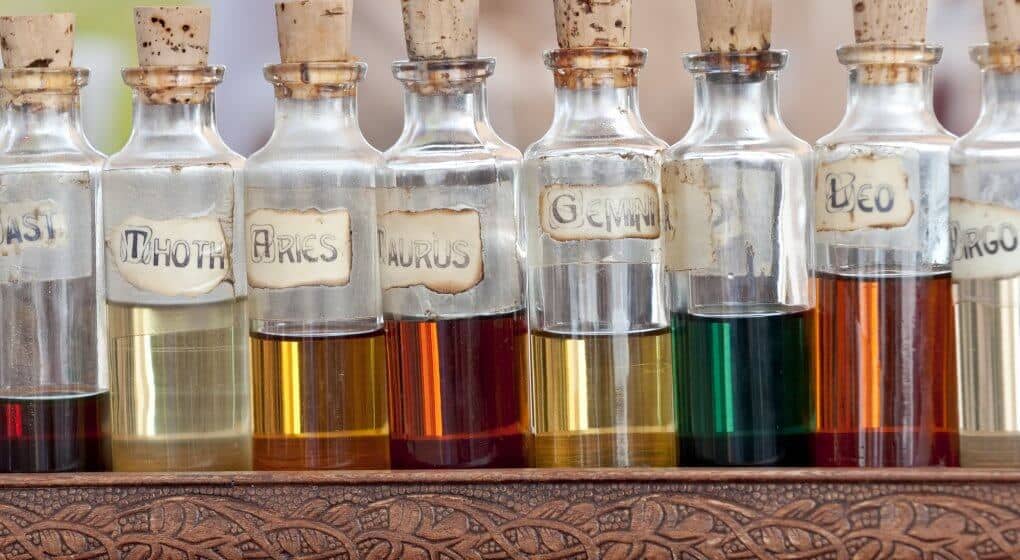Essential oils contain chemical constituents that can be quite strong and irritating. They aren’t so strong that they would cause third degree burns or anything, but many of them can cause an uncomfortable reaction. The most common reaction is temporary redness and mild irritation.
Some essential oils, however, can cause sensitization that may be permanent. If you do develop permanent sensitization, you will have an allergic reaction to that oil, or oils with the same chemical constituents, for the rest of your life. It really isn’t worth the risk.
Think of essential oils as active ingredients that need to be mixed with inert ingredients to make them more tolerable, like cold medicine or skin cream. If you read the label on the decongestant or skin cream in your bathroom cabinet, you’ll see the active ingredients listed separately or first on the label followed by inactive ingredients. Essential oils are the active ingredients in your topical oil and the carrier oil is the inactive ingredient.
Step 1: Determine the Appropriate Dilution Rate

Do a little research on the essential oil or oils you want to use. Find out the best dilution rate for that oil. In general, 1 to 2 drops of essential oil per 1 teaspoon of carrier oil is a safe dilution rate. That translates to a 1% to 2% dilution rate. Essential oils that are diluted to that strength can generally be used daily without risk of irritation or sensitization.
There are some essential oils that should be diluted even further. For example, ylang ylang complete essential oil should be diluted to only .8% strength to avoid sensitization or irritation. Ylang ylang complete is a highly concentrated essential oil.
Once you smell it, you will understand just how strong it is. Jasmine absolute is another one that is extremely strong. It is solvent-extracted from jasmine blooms. That one should be diluted only to .7%.
Find out if the essential oil you have purchased is full strength or already diluted. Jasmine is often sold pre-diluted in fractionated coconut oil. If this is what you’ve purchased, then you are all set. There is no need to dilute it further.
If you are going to blend a number of different essential oils together, make sure they are compatible. Remember, some of these oils have a high concentration of chemical constituents. You don’t want to mix two or more essential oils together that are both high in the same constituents.
Consider each oil’s fragrance notes, too, when deciding which essential oils to blend together. Each oil presents a top, middle or base note, although some will straddle two classifications. The top-note oils fade quickly, middle-note oils fade a little more slowly and base-note oil fragrances stick around the longest.
Essential oils are also categorized according to what they smell like. Black pepper oil, for instance, has a spicy, base-to-middle fragrance note. Jasmine essential oil has a floral, base-to-middle fragrance note.
That means the jasmine fragrance will last, so you better be sure you like it before you add it to your blend. Peppermint essential oil has a camphoraceous, top-note fragrance that fades fairly quickly.
*Essential oils for children and the elderly should be diluted to half the strength recommended for topical use on adults.*
Step 2: Select a Carrier Oil

Choose a carrier oil that will meet your needs. There are many available carrier oils and most of them have therapeutic properties of their own. If you want to use an essential oil to treat a skin condition like eczema or psoriasis, for example, almond oil, apricot kernel oil, avocado oil, babassu oil, borage oil, grapeseed oil, jojoba oil, kukui nut oil and virgin olive oil are ideal carrier oils.
If you just want to use essential oils to moisturize aging skin or reduce the signs of aging, select a carrier oil that is especially good for that purpose. Virgin olive oil, yes, the same olive oil that many of us cook with, is excellent for moisturizing dry, aging skin.
Rosehip seed oil is another carrier oil that is ideal for use as a moisturizer for very dry skin. It helps eliminate scars or stretch marks and actually improves the elasticity of skin.
Consider combining carrier oils for a more complete blend. One of my favorite carrier oil blends consists of 1/3 virgin olive oil, 1/3 kukui nut oil and 1/3 rosehip seed oil. Combining essential oils is a great way to get the benefits of a heavier oil, like olive oil or jojoba oil, without ending up with skin that is too oily. Kukui nut oil is a great summer oil. It is light and absorbs very quickly. Rosehip seed oil also absorbs quickly.
Aloe vera jelly can also be used as a carrier for essential oils. It has to be aloe vera jelly that contains thickening agents, though. You shouldn’t use aloe vera gel or just plain aloe vera straight from the plant.
Step 3: Use Glass or Pyrex Containers
Blend the oils in glass or pyrex containers. Even if you just use a plastic cup to blend the oils and quickly pour them into a glass container, the essential oils can soak into the plastic and begin to degrade it. For best results, use a pyrex or glass measuring cup with a spout to mix the oils.
That makes it much easier to pour them into a storage container. Always store your essential oils in glass containers. If you try to store them in plastic, they will dissolve the plastic. You can blend your oils right in the storage container or dropper bottle, if you prefer.
Step 4: Blend Essential Oils First
Put the essential oils into the mixing or storage container before you add the carrier oil, especially if you are blending multiple oils for the first time. That way, you can play with the oil blend until you get exactly what you want.
Put the minimum number of drops of each oil into the container, swirl them around to mix them together, let them set for a few minutes then smell the blend. If it needs a little more of one oil or another, adjust the blend with one drop at a time.
After you think you’ve got it, add the carrier oil to the container and stir or swirl to blend the oils. If you mix them in a glass dropper bottle, cap the bottle and give it a shake.
Let the oil set overnight or even up to a few days then smell it again. Oils will settle into each other over time. Your perfect blend may smell noticeably different after a day or two. You might want to adjust the next batch accordingly.
Step 5: Write Down the Recipe

Write down how many drops of each essential oil you use in a blend. That makes it easier to keep track of what works and what doesn’t. It’s also a good idea to make a note of the date you put together each blend.
Step 6: Label the Bottle

Label each bottle so you know what’s in it. You may think you can figure it out by smelling the oil, but it is much easier to simply look at the label. You can use a sticky label or a marker designed for writing on glass. There are also kits you can buy that include the bottles, dropper tops and a marker.
You can abbreviate the oils in the blend and just write the abbreviations on the bottle or name your blends. The marker tends to last longer if you write on the bottom of the bottle, rather than the side.
Step 7: Store Diluted Oils Properly

Diluted oils should be kept in a dark, cool place if they aren’t going to be used within a few days. Keep them in the refrigerator, if possible. If you don’t want the essential oils in the refrigerator because you have young children in the house who may get into them, put your oils in a cool dark place.
The back of a high cupboard that stays fairly cool should be fine. You should always store essential oils, whether diluted or undiluted, in a dark glass bottle. Exposure to light will cause them to oxidize or go bad more quickly than usual.
Was this guide helpful? Diluting essential oils in a variety of carrier oils can be just as much fun as coming up with great-smelling blends. It really amazes me how much difference a carrier oil can make. Experiment with lighter and heavier oils or try some of the less commonly known exotic carrier oils. You may find a new favorite that works perfectly for your skin.
Please leave a comment to let me know if this step-by-step guide was helpful and share your own experiences with diluting essential oils. Let me know which carrier oils you’ve tried, what works best for you and which ones you found disappointing. Be sure to share, too, so that others can learn about how to dilute essential oils.
References:
1. AromaWeb: Guide to Diluting Essential Oils
https://www.aromaweb.com/articles/dilutingessentialoils.asp
2. AromaWeb: Aromatic Blending of Essential Oils
https://www.aromaweb.com/articles/aromaticblending.asp
3. Hopewell Oils: Jasmine Grandiflorum
https://hopewelloils.com/jasmine-grand.php

